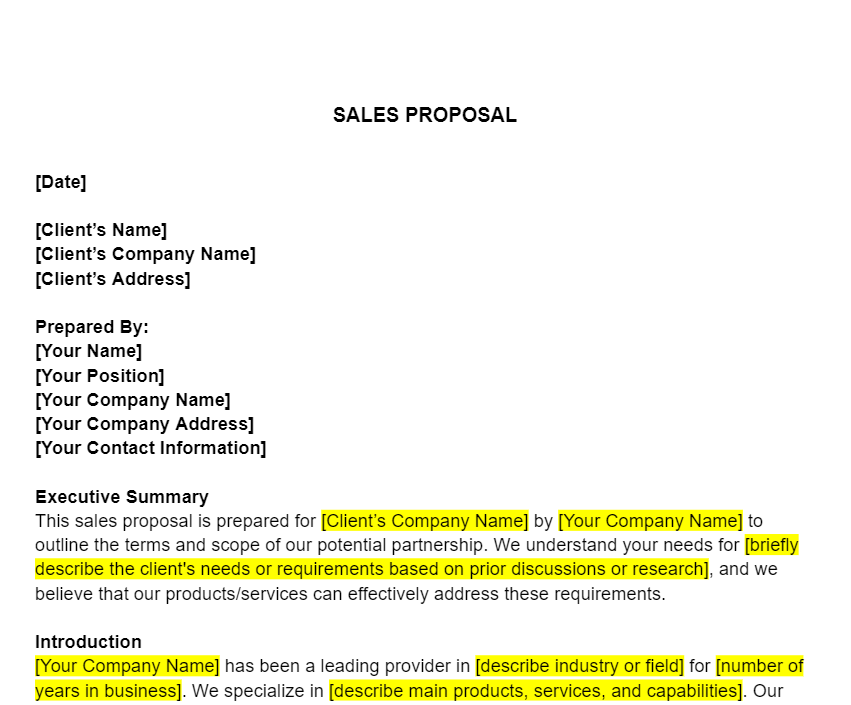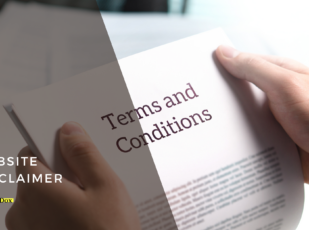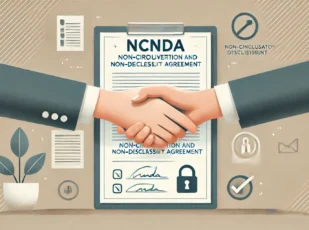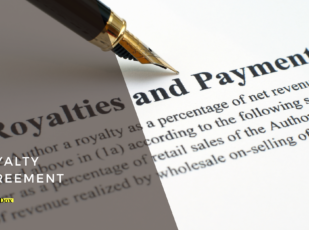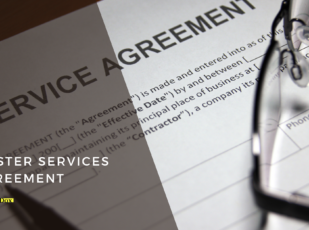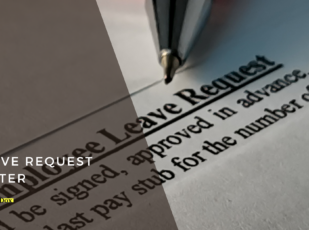
Sales Proposal Template
14 Downloads
Corporate, Money and Finances
February 17, 2025
Sayantani Dutta
Over time, winning new clients and closing deals seems to have become tougher. Though it can be attributed to the rising competition in almost all fields, the art of selling has not become less or more effective. The ability to sell remains a core tenet of the modern corporate world—and the Sales Proposal is the tool with which we draft everything from business proposals to value propositions. A winning sales proposal is an indispensable tool for outlining your offerings to prospective clients or potential customers in a structured, persuasive manner.
This document highlights the benefits of your product, service, or idea efficiently. The objective? To put across the value in meeting the potential client’s needs or fixing a problem. It can be interactive with graphs and pricing tables to make things interesting for prospective customers, or just an excellent, to-the-point sales pitch or proposed solution that tells the client how you will work on the pain points, what the deliverables will be, and any testimonials or case studies that bolster your pitch.
Either way, you need a starting point. In fact, a successful Sales Proposal begins with a good Sales Proposal Template. Today, we are going to tell you how you can ensure consistency, professionalism, and efficiency in drafting your top-notch sales pitches! Whereas a free template for this might sound like a good starting point, great sales proposals rarely originate that way. After covering the importance of a strong Sales Proposal and the pitfalls of relying on generic templates, we will also give you access to our novel, customizable Sales Proposal Template that will make sure your offer is put across in the best way possible, every time.
Ready to supercharge your sales team? Let’s look at the importance of the Sales Proposal.
Why Does a Sales Proposal Matter?
The sales process is nuanced and oftentimes complex. The idea that you have worked on for a while now or have complete knowledge of is not something the prospects or decision-makers (consumers, clients, stakeholders, etc.) have the time to experience firsthand. That is why it is often said to keep the sales pitch short, to the point, impactful, and succinct.
Better said than done!
That is why a Sales Proposal matters so much. It is not a single tagline, neither is it an in-depth digression into what makes your product superior, for example. It strikes the right balance between those two extremes.
Creating persuasive communications tailored to the needs and challenges of each prospect is much more than choosing the right words. The most accomplished sales reps know that research into the prospect or the target market/demographics is just as important a methodology as actually drafting the proposal. The prospect needs to be mapped, current solutions tested, ideas to solve problems thrown around, and everything in between. Only after these processes and metrics can you determine the right scope of work that will be required and decide on the pricing.
For example, let’s say you are making a Sales Proposal for a client to handle their social media marketing needs. For an ecommerce startup working with a smaller ticket size, the proposal will be very different from what you create for, let’s say, a small business already handling huge volumes of product through their physical stores. For SMEs and larger companies, you will need even more customization and unique offerings that solve their problems specifically. This is why service providers need to have a solid base that they can customize to ease the entire pitching and onboarding experience.
A good process saves time and improves efficiency by providing a consistent framework. Every proposal needs to communicate the core messages, such as your own strengths, effectively and professionally. On the other hand, the proposal needs to have unique solutions specific to the prospect. In other words, your proposal needs to cover your highlights, which remain the same, while also addressing specific client scenarios to make each proposal feel personal.
Whether you are pitching CRM integrations, a tech stack to automate legacy processes, or product launch marketing campaigns—it all hinges on a good Sales Proposal.
Moving Ahead with Inadequate Templates
A ton of free, generic Sales Proposal Templates are available on the web. These docs have all the usual suspects, as in headings. Or at least it appears that way. In reality, oftentimes, these templates are not comprehensive enough. They do not have important sections that might be useful in your pitch. Furthermore, they might have a general lack of comprehensiveness in their coverage of the core messaging.
All this can lead to inconsistencies in the information presented to potential clients, potentially undermining the professionalism and effectiveness of your sales efforts. It can also increase the time sales teams spend on each proposal.
In any case, it brings down the overall productivity and success of the sales team—possibly also leading to missed opportunities that cost you a lot.
Inadequate, generic, and free templates are often not comprehensive or attractive enough to carry your pitch. With them, you are most likely to have a high failure rate. Plus, everyone else is pretty much using the same templates, so they all look alike, with the language feeling similar as well, even for entirely different scopes of work!
The 4 Parts of a Good Sales Proposal
Any good Sales Proposal will have at least these four components/sections. Apart from these, you are free to include additional sections depending on what’s available and the nature of your work—such as case studies, reviews and testimonials, existing clients list, equipment/tool USPs, awards and accolades, etc.
The four main parts are as follows:
1. Executive Summary
The Executive Summary is the hook—the first impression that can make or break your sales proposal. It’s not just a recap of what’s to come; it’s where you capture the prospect’s attention by succinctly presenting the essence of your offering. Think of it as the elevator pitch of your proposal, highlighting what you’re bringing to the table and why it matters.
A strong executive summary should focus on:
- The key challenges or pain points the prospect is facing.
- A brief overview of your proposed solution and its potential impact.
- A snapshot of the value you bring—whether it’s cost savings, efficiency improvements, or strategic advantages.
Keep this section short and impactful. Decision-makers often skim through proposals, and this is the part they are most likely to read. Avoid technical jargon or overwhelming details here. Focus mainly on creating a compelling narrative that shows you understand their needs and have the right solution. In fact, the part of “understanding their needs” is actually more important in many cases than the actual solution you propose. It creates an instant connection and in some rare cases, if nobody else has understood those needs or pain points, it makes your sales pitch a thousand times better than anything else.
2. Client Needs
Before broadcasting what you offer, it is also very important to first create a deep understanding of the prospect’s pain points and goals. The Client Needs section lays out what the client is struggling with and how it affects their business operations, growth, or bottom line. You are essentially telling them what they should know or what they already know. Be specific here—they need to know precisely why/how their business is being affected.
This section should include:
- A clear articulation of the client’s current challenges.
- Insights into how these challenges impact their business.
- A connection to their broader objectives or aspirations.
This is where your research pays off. Show them that you have done your homework by personalizing this section with specific details rather than relying on generic statements. The more aligned your proposal is with their real-world problems, the more likely they are to see you as a credible partner.
3. Proposed Solution
Once all the challenges are clear, it is now time to present your Proposed Solution. This section is the heart of the proposal—it is where you outline exactly how you plan to address the client’s needs with your product or service.
Your proposed solution should include:
- A detailed description of your offering and how it aligns with the client’s needs.
- The process or methodology you will follow to achieve results.
- Key deliverables, timelines, and milestones to set expectations.
Be clear and concise, but don’t just list features—frame your solution in terms of the benefits it offers. How does it solve their problem better than alternatives? What makes your approach unique? This is also the place to highlight any flexibility in your offering that can be suited to their specific needs.
4. Pricing Information
Let’s be honest—this is one of the first things clients look at, so your Pricing Information needs to be transparent and well-structured. Pricing should be laid out in a way that makes it easy for the prospect to understand the value they’re getting for their investment. Many companies make the mistake of not being confident about their own pricing, particularly businesses that are just beginning. Once you have a number, stick to it as if it is God’s very own word. This is how much it costs. You have to believe it first to make the prospect believe it too.
Ideally, your pricing section should cover:
- A breakdown of costs, whether it’s a one-time fee, subscription, or tiered pricing model.
- Any optional add-ons or upsell opportunities that could enhance the offering.
- Payment terms, including due dates, accepted payment methods, and potential discounts for early commitment.
Avoid vague pricing that leaves room for confusion. Instead, opt for clear, itemized details that build trust and make decision-making easier for the client. If applicable, show a comparison of costs versus benefits to reinforce the value you provide.
Draft Masterful Sales Proposals with FreshDox.com
Now, you too can be a master of Sales Proposals! Here is our sales pitch:
- FreshDox.com has a professionally designed Sales Proposal Template that you can customize.
- It is developed by sales and marketing professionals who already understand what works, what the necessary components are, and how the core messaging is best conveyed to close deals.
- Our Sales Proposals Template comes with sections and contents to suit all needs! All you need to do is add, remove, or edit these sections and have a top-notch document ready for sending.
- The Sales Proposal Template is available on both PDF and Word formats.
- A single FreshDox.com account gives you access to literally hundreds of business-related, professional, and legal document templates to cover all bases and organizational requirements.
- We have a 14-day trial period that you can use to test our Basic and Premium Membership Plans risk-free! Basic Members can download up to three document templates per month and Premium Members have unlimited access.
Still thinking? Well, what if we told you dozens of organizations have already benefited from our professionally-drafted document templates? If you are ready to take your sales strategy a leg up, FreshDox.com’s Sales Proposal Template will be waiting for you. Register today and start creating proposals that stand out and close deals.
Related Templates
Discover more templates that align with your needs and preferences.

Ready to Sign Up?
Sign up for FreshDox.com’s 7-day trial and discover why so many individuals and businesses trust us for their legal document template needs.
- Cancel any time
- 7-day free trial
- From 300+ Customer Reviews

